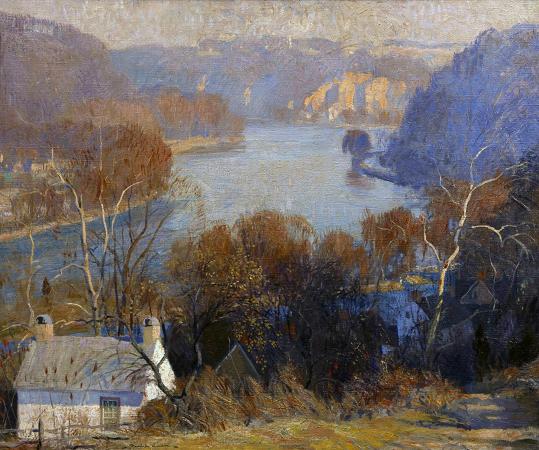
New Hope School. Pennsylvania Impressionism was an American Impressionist movement of the first half of the 20th century that was centered in and around Bucks County, Pennsylvania, particularly the town of New Hope.
The movement is sometimes referred to as the New Hope School or the Pennsylvania School of landscape painting. Landscape painter William Langson Lathrop moved to New Hope in 1898, where he founded a summer art school.
The mill town was located along the Delaware River, about forty miles from Philadelphia and seventy miles from Manhattan. The area's rolling hills were spectacular, and the river, its tributaries, and the Delaware Canal were picturesque.
The natural beauty attracted the artist Edward Redfield, who settled north of the town. Redfield painted nature in bold and vibrant colors, and was the pioneer of the realistic painting of winter in America.
His thick layering distinguished him from his contemporaries, and he amassed more honors and awards than any other artist in the New Hope Colony. His style is distinguished by its color, light, and usual time of day when painting. The third major artist to settle in the area was Daniel Garber, who came to New Hope in 1907. Garber hated painting winter scenes and applied his paint lightly. An instructor at the Pennsylvania Academy of the Fine Arts in Philadelphia, Garber played a huge part of the new colony. Garber made rain paintin
The movement is sometimes referred to as the New Hope School or the Pennsylvania School of landscape painting. Landscape painter William Langson Lathrop moved to New Hope in 1898, where he founded a summer art school.
The mill town was located along the Delaware River, about forty miles from Philadelphia and seventy miles from Manhattan. The area's rolling hills were spectacular, and the river, its tributaries, and the Delaware Canal were picturesque.
The natural beauty attracted the artist Edward Redfield, who settled north of the town. Redfield painted nature in bold and vibrant colors, and was the pioneer of the realistic painting of winter in America.
His thick layering distinguished him from his contemporaries, and he amassed more honors and awards than any other artist in the New Hope Colony. His style is distinguished by its color, light, and usual time of day when painting. The third major artist to settle in the area was Daniel Garber, who came to New Hope in 1907. Garber hated painting winter scenes and applied his paint lightly. An instructor at the Pennsylvania Academy of the Fine Arts in Philadelphia, Garber played a huge part of the new colony. Garber made rain paintin
Wikipedia ...